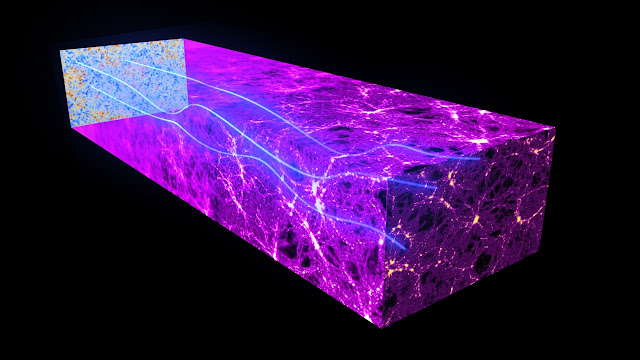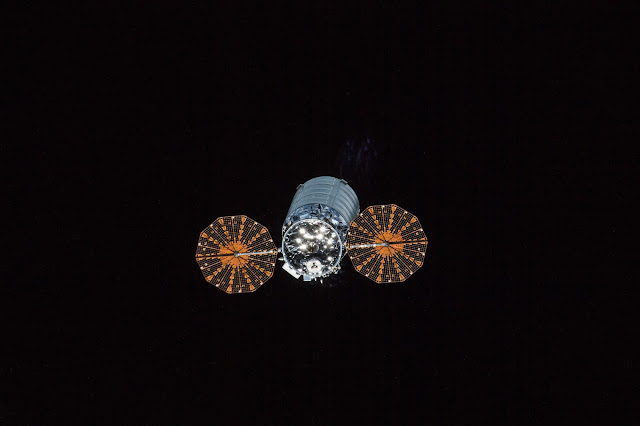ESA - Planck Mission patch.
18 April 2019
Scientists have used the tiny distortions imprinted on the cosmic microwave background by the gravity of matter throughout the Universe, recorded by ESA's Planck satellite, to uncover the connection between the luminosity of quasars – the bright cores of active galaxies – and the mass of the much larger 'halos' of dark matter in which they sit. The result is an important confirmation for our understanding of how galaxies evolve across cosmic history.
Image above: Gravitational deflection by quasar-hosting dark matter halos. Image Credits: David Tree, Professor Peter Richardson, Games and Visual Effects Research Lab, University of Hertfordshire.
Most galaxies in the Universe are known to host supermassive black holes, with masses of millions to billions of times the Sun's mass, at their cores. The majority of these cosmic monsters are 'dormant', with little or no activity going on near them, but about one percent are classified as 'active', accreting matter from their surroundings at very intense rates. This accretion process causes material in the black hole's vicinity to shine brightly across the electromagnetic spectrum, making these active galaxies, or quasars, some of the brightest sources in the cosmos.
While it is still unclear what activates these black holes, switching on and off their phase of intense accretion, it is likely that quasars play an important role in regulating the evolution of galaxies across cosmic history. For this reason, it is crucial to understand the relationship between quasars, their host galaxies, and their environment on even larger scales.
In a recent study led by James Geach of the University of Hertfordshire, UK, scientists have combined data from ESA's Planck mission with the largest survey of quasars available to date to shed light on this fascinating topic.
Planck. Image Credit: ESA
According to the leading scenario of structure formation in the Universe, galaxies take shape out of ordinary matter in the densest knots of the cosmic web – a filamentary network, made up primarily of the invisible dark matter, that pervades the cosmos. In turn, the complex distribution of both ordinary and dark matter originates from tiny fluctuations in the primordial Universe, which leave an imprint in the Cosmic Microwave Background (CMB), the most ancient light in the history of the Universe.
The Planck satellite has been scanning the sky between 2009 and 2013 to create the most precise all-sky map of the CMB, enabling scientists to refine our knowledge of the age, expansion, history, and contents of the Universe to unprecedented levels of accuracy.
And there is more: as predicted by Albert Einstein's general theory of relativity, massive objects bend the fabric of spacetime around them, distorting the path of everything – even light – that passes nearby. This phenomenon, known as gravitational lensing, affects also Planck's measurements of the CMB, which carry an imprint of the large-scale distribution of matter that the most ancient cosmic light encountered along its way to the satellite.
Image above: Gravitational lensing of the Cosmic Microwave Background. (See also the animated version of this image.) Image Credits: ESA and the Planck Collaboration.
"We know that galaxies form and evolve within an invisible 'scaffolding' of dark matter that we cannot directly observe, but we can exploit the gravitational lensing distortions imprinted on the cosmic microwave background to learn about the dark matter structures around galaxies," says James Geach.
Gravitational lensing distortions of the CMB are small, rearranging the CMB sky picture on scales of about 10 minutes of arc – equivalent to just one third the diameter of the full Moon. But many tiny deflections from across the sky can be combined, with the help of statistical methods, to obtain a stronger signal, piling up the data gathered around many quasars.
In their research, Geach and colleagues analysed the latest gravitational lensing map obtained by the Planck team, made public as part of the Planck Legacy Release in 2018, in combination with 200 000 quasars drawn from the largest sample ever compiled, the more than half-a-million quasars that comprise Data Release 14 of the Sloan Digital Sky Survey quasar catalogue.
"By combining the Planck data with such a large sample of quasars, we could measure the mass of the dark matter halos in which the quasar host galaxies are embedded, and investigate how this varies for quasars of different luminosity," says Geach.
The analysis hints that that the more luminous a quasar is, the more massive its halo of dark matter.
"This is compelling evidence that a correlation exists between the luminosity of a quasar, energy that is released in the immediate vicinity of a supermassive black hole – a region spanning perhaps a few light days – and the mass of the encompassing halo of dark matter and surrounding environment, which extends for tens of millions of light years around the quasar," Geach explains.
Image above: Gravitational deflection by quasar-hosting dark matter halos. Image Credits: David Tree, Professor Peter Richardson, Games and Visual Effects Research Lab, University of Hertfordshire.
"We're using the cosmic microwave background as a kind of 'backlight' to the Universe. That backlight has been gravitationally lensed by foreground matter, and so by correlating galaxies with the Planck lensing map, we have a new way to study galaxies and their evolution."
The finding supports theoretical models of quasar formation, which predict a correlation between quasar luminosity and halo mass, in particular for the most luminous quasars, where the black holes are accreting matter at close to the maximum rate.
The study focused on distant quasars that are observed as they were when the Universe was about four billion years old – about one third of its current age of nearly 14 billion years. This is close to the peak era of supermassive black hole growth. In combination with deeper quasar surveys in the future, the Planck data could enable scientists to push these investigations to even earlier times in cosmic history, up to the epoch when the first quasars formed.
"This result shows the power of Planck's gravitational lensing measurements, which make it possible for us to measure the invisible structures of dark matter in which galaxies form and evolve," says Jan Tauber, Planck project scientist at ESA.
"The legacy of Planck is quite astonishing, with data that are being used for a much wider range of scientific applications than originally conceived for."
Notes for editors"The halo mass of optically-luminous quasars at z~1–2 measured via gravitational deflection of the cosmic microwave background" by J. E. Geach et al. is published in The Astrophysical Journal, Volume 874, Number 1:
https://doi.org/10.3847/1538-4357/ab0894Launched in 2009, Planck was designed to map the sky in nine frequencies using two state-of-the-art instruments: the Low Frequency Instrument (LFI), which includes three frequency bands in the range 30-70 GHz, and the High Frequency Instrument (HFI), which includes six frequency bands in the range 100-857 GHz. Seven of Planck's nine frequency channels were equipped with polarisation-sensitive detectors. HFI completed its survey in January 2012, while LFI continued to make science observations until October 2013.
ESA Planck:
http://sci.esa.int/planck/Images (mentioned), Text, Credit: ESA/Jan Tauber/Centre for Astrophysics Research/University of Hertfordshire/James E. Geach.
Greetings, Orbiter.ch











































